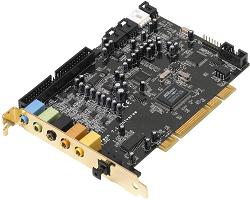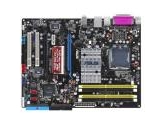|
Why buy an Add-on Sound Card?

Comparison
Now that the technical jargon is out of the way, lets take a look at some of the features and specifications available on the market today. Here we have a high-end motherboard with an integrated 7.1 channel surround sound compared to high-end sound card.
Product |
MSI P7N Diamond LGA 775 NVIDIA 780i | ASUS Xonar D2X 7.1 Channels 24-bit 192KHz PCI Express |
|---|---|---|
| Image |  |
 |
| Price | $259.99 |
$199.99 |
| Digital Audio Depth | 24 bits |
24 bits |
| SNR | 108 dB |
118 dB |
| Input Sampling Rate | 96 KHz |
192 KHz |
| Output Sampling Rate | 96 KHz |
192 KHz |
There are also other things to consider when deciding between onboard sound and a sound card. The onboard sound utilizes you processor to decode and encode sound. The impact on the processor varies depending on the things you are doing. Video playback, for example, does not require much encoding/decoding action from your processor, as opposed doing something more process intensive, such as recording something in pure raw format in real time. This comes into play with your DVR devices such as your home media center PC recording a TV show or ripping music from a CD to mp3 on your PC.
Sound cards tend to have more abilities in terms of input; the ASUS Xonar D2X, for example, is capable of multi-channel digital encoding in real time. Most modern sound cards feature a MIDI interface which can be used to plug in your musical instrument and doubles as a joy stick connector as well as 7.1 channel surround sound capabilities. Some of the other standard interfaces are component and HDA cable connections, and remote controls. Different brands of sound cards make different designs with different interfaces.
Conclusion:
The difference between the onboard audio and discrete audio is apparent, but what do these numbers mean? Having higher sampling rate means that the sound card you are using will be able to produce higher pitch sounds than your on board sound. Higher SNR means less background noise. Since the majority of the people who own CD's don't complain about the quality of the audio (about 100dB SNR), having a sound card that produces more than that is generally unnecessary. On a side note, most compression formats such as mp3 and wav work by eliminating frequencies. If you are considering playing songs in mp3 format, your high quality system will sound just as good as mid-range one. High quality sound cards work amazingly well when recording into raw format, in which case they try to capture a wider range of frequencies without consideration of how much space the audio file takes up. For the average user, onboard audio is enough, but for users interested ultimate quality sound cards are a way to go.
Buy a sound card if: You like to get that little bit of extra performance out of your cpu, if you are an avid gamer, or you are looking for great sound in your recording studio.
Don't buy a sound card if: You are a general user and enjoy watching movies, or have a computer for your general every day tasks.




